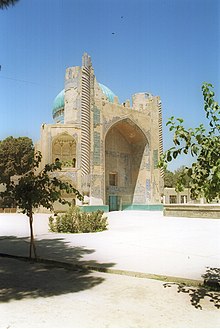Rabia Balkhi

Rabia Balkhi,also known asRabia al-Quzdari(orKhuzdari)[a]was a 10th-century writer who composed poetry inPersianandArabic.She is the first known female poet to write in Persian.
A non-mysticpoet, her imagery was later transformed into that of a mystic poet by authors such asAttar of Nishapur(died 1221) andJami(died 1492). She became a semi-legendary figure, famous for her love story with the slave Bektash.
Her shrine is located in the mausoleum of the 15th-centuryNaqshbandiSufiKhwaja Abu Nasr Parsa(died 1460) in the city ofBalkh,now present-dayAfghanistan.She is celebrated in theBalochistan provinceofPakistan,Afghanistan andIranthrough various schools, hospitals, and roads being named after her.
Background
[edit]She is known by various names, Rabia Balkhi, Rabia al-Quzdar (or Khuzdari), and anonymously as a "daughter of Ka'b". Most of her life is considered to be obscure.[1]Rabia was said to have been descended from anArabfamily that had settled inKhurasanfollowing theMuslim conquest.[2]TheIranologistVladimir Minorskyconsidered her last name, Quzdari, to connect her to the city ofKhuzdarinBalochistan.The GermanOrientalistHellmut Ritterdismissed the narrative that Rabia's father was an Arab who ruled overBalkh,which the modern historian Tahera Aftab considers to indirectly support Rabia's connection to Khuzdar.[4]According to the IranologistHamid Dabashi,Rabia was aPersianizedArab.[5]
Biography
[edit]Rabia lived during the same period as the poetRudaki(died 940/41), and is the first known Persian woman poet.[2]She felt strongly aboutSufism,and composed poetry in Persian and Arabic.[1]The 14th-century poet andanthologistJajarmistates that Rabia wrote a Persian poem which used Arabic for theshahadaandlahwalah,which according to the Iranologist Francois de Blois demonstrates her enthusiasm for bilingual tricks.[6]
Rabia appears in theLubab ul-Albab,a compilation of Persian poets made by the 12th and 13th-century writerAwfi(died 1242). The compilation says the following about her: "The daughter of Ka'b, although she was a woman, was superior to men in accomplishments. She possessed great intelligence and sharp temperament. She used to continuously play the game of love and admired beautiful youths."[1]Rabia is amongst the thirty-five female Sufis mentioned in the 15th-century Persian workNafahat al-Uns,a biographical compilation made byJami(died 1492). Referring her as the "daughter of Ka'b", Jami narrates the story through the prominent Sufi master and poet,Abu Sa'id Abu'l-Khayr(died 1049), reporting that she fell in love with a slave.[7]
A romanticized version of this story appears in theIlahi-namaof the Sufi poetAttar of Nishapur(died 1221), under a story namedHikayat Amir-i Balkh wa ashiq shudan dukhtar-i o( "the story of the chieftain of Balkh and his daughter's falling in love" ). The story narrates Rabia's love affair with Bektash, a slave of her brother Haris, and concludes with the death of both Rabia and Bektash. Attar does not use the name "Rabia" either when referring to her, and instead calls herZainu'l Arab( "the ornament of the Arabs" ). He reports that she was so attractive that it was almost impossible to describe her beauty. Francois de Blois dismisses Attar's story, considering it to have "no value as a biographical source" for Rabia.[7]
The modern historian Sunil Sharma notes that Rabia initially started out as non-mysticfigure, being portrayed by Awfi as a "boy-chasing intelligent woman", and was only later portrayed as a mystic poet by authors such as Attar and Jami.[3]Dabashi notes that Rabia later became a "semi-legendary figure who putatively wrote her last poems with her blood on the prison walls of the jail in which she had been incarcerated because of her love for a slave named Bektash."[8]Her love story with Bektash encouraged the 19th-century writerReza-Qoli Khan Hedayat(died 1871) to write the romantic epic ofGolestan-e EramorBektash-nama,which tells the story of the two pairs.[9][10]
Rabia's shrine is located in the mausoleum of the 15th-centuryNaqshbandiSufiKhwaja Abu Nasr Parsa(died 1460) in the city of Balkh, now present-dayAfghanistan.[11]The shrine was renovated between 2012 and 2016.[12]She is celebrated in theBalochistan provinceofPakistan,Afghanistan andIranthrough various schools, hospitals, and roads being named after her. Women consider her to serve as a replacement for their lost voice. The 1974 Afghan filmRabia of Balkhnot only played a central role in thecinema of the country,but according to Krista Geneviéve Lynes "also in the figuration of a proto-feminist political agency, one that in many respects resembles the ethnical call for justice inSophocles'sAntigone."[11]
Notes
[edit]References
[edit]- ^abcdAftab 2022,p. 205.
- ^abcDabashi 2012,p. 89.
- ^abSharma 2009,p. 151.
- ^Aftab 2022,pp. 206–207.
- ^Dabashi 2012,p. 90.
- ^Blois 2004,p. 189.
- ^abAftab 2022,p. 206.
- ^Dabashi 2012,pp. 89–90.
- ^Losensky 2003,pp. 119–121.
- ^Rypka 1968,p. 144.
- ^abAftab 2022,p. 207.
- ^Khwaja Parsa Complex Conservation.
Sources
[edit]- Aftab, Tahera (2022).Sufi Women of South Asia: Veiled Friends of God.Brill.ISBN978-9004467170.
- Blois, Francois de (2004).Persian Literature - A Bio-Bibliographical Survey: Poetry of the Pre-Mongol Period (Volume V).Routledge.ISBN978-0947593476.
- Dabashi, Hamid(2012).The World of Persian Literary Humanism.Harvard University Press.ISBN978-0-674-06759-2.
- "Khwaja Parsa Complex Conservation".archnet.org.Retrieved30 October2022.
- Losensky, Paul E. (2003)."Hedayat, Reżāqoli Khan".InYarshater, Ehsan(ed.).Encyclopædia Iranica, Volume XII/2: Hedāyat al-mota'allemin–Herat VII.London and New York: Routledge & Kegan Paul. pp. 119–121.ISBN978-0-933273-75-7.
- Rypka, Jan(1968).History of Iranian Literature.Springer Netherlands.ISBN978-9401034814.
- Sharma, Sunil (2009)."From ʿĀʾesha to Nur Jahān: The Shaping of a Classical Persian Poetic Canon of Women".Journal of Persianate Studies(2).Brill:148–164.doi:10.1163/187470909X12535030823698.Archived fromthe originalon 3 August 2022.Retrieved1 August2022.
Further reading
[edit]- Havlioglu, Didem (2017).Mihrî Hatun: Performance, Gender-Bending, and Subversion in Ottoman Intellectual History.Syracuse University Press.ISBN978-0815635376.
- Hillmann, Michael Craig (2022). "Use of Translations of Classic Persian Poems in the Study of Persian".The Routledge Handbook of Persian Literary Translation.Routledge. pp. 334–385.ISBN978-0367510411.
